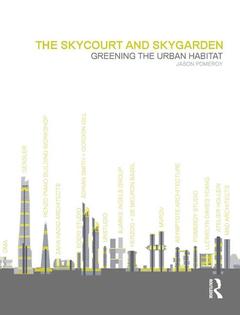The Skycourt and Skygarden Greening the urban habitat
Auteur : Pomeroy Jason

Population increases, advances in technology and the continued trend towards inner-city migration have transformed the traditional city of spaces into the modern city of objects. This has necessitated alternative spatial and technological solutions to replenish those environments that were once so intrinsic to society?s day-to-day interactions and communal activities.
This book considers skycourts and skygardens as ?alternative social spaces? that form part of a broader multi-level urban infrastructure ? seeking to make good the loss of open space within the built environment. Jason Pomeroy begins the discussion with the decline of the public realm, and how the semi-public realm has been incorporated into a spatial hierarchy that supports the primary figurative spaces on the ground or, in their absence, creates them in the sky. He then considers skycourts and skygardens in terms of the social, cultural, economic, environmental, technological and spatial benefits that they provide to the urban habitat. Pomeroy concludes by advocating a new hybrid that can harness the social characteristics of the public domain, but be placed within buildings as an alternative communal space for the 21st century.
Using graphics and full colour images throughout, the author explores 40 current and forthcoming skycourt and skygarden projects from around the world, including the Shard (London), Marina Bay Sands (Singapore), the Shanghai Tower (China) and the Lotte Tower (South Korea).
Foreword Ken Yeang. Preface. Part 1: Civility, Community and the Decline of the Public Realm 1.1 The public realm, civility and community 1.2 The decline of the public realm, and the privatisation of space 1.3 From a city of spaces to a city of objects 1.4 Loss of open space and its socio-environmental implications 1.5 The birth of alternative social spaces Part 2: Defining the skycourt and skygarden 2.1 The skycourt and skygarden: a historical overview 2.2 The skycourt and skygarden: spatial morphology and perceived density 2.3 The skycourt and skygarden as a social space 2.4 The skycourt as a transitional space 2.5 The skycourt and skygarden as an environmental filter 2.6 The skycourt and skygarden: enhancing psycho - physiological well-being 2.7 The skycourt and skygarden as a bio-diversity enhancer 2.8 The skycourt and skygarden: their economic benefits 2.9 The skycourts and skygarden as part of a new legislated urban vocabulary Part 3: Global Case Studies 3.1 Completed projects 3.2 Under construction 3.3 On the drawing board 3.4 Future vision Part 4: Towards a Vertical Urban Theory 4.1 The skycourt and skygarden: evolutionary observations 4.2 Sustainable principles to support a vertical urban theory
Jason Pomeroy is an award-winning architect, masterplanner and academic at the forefront of the sustainable built environment agenda. He graduated with distinction from the Canterbury School of Architecture and Cambridge University, and is the founding Principal of Pomeroy Studio. He provides the direction of the Studio’s creative output and research programme. In addition to leading Pomeroy Studio, he lectures internationally and publishes widely, and is the author of Idea House: Future Tropical Living Today. He is an Adjunct Professor at the University of Nottingham, and Visiting Faculty to a number of other institutions. He also sits on the editorial board of the Council on Tall Buildings and Urban Habitat.
Date de parution : 12-2013
18.9x24.6 cm
Thèmes de The Skycourt and Skygarden :
Mots-clés :
Malaysian tall buildings; social spaces; high rise gardens; The Shard; Commerzbank; Shanghai tower; Vertical Urban Theory; Urban Heat Island; Highest Urban Heat Island Intensities; Assoc Iates; Greater Wall; Green Walls; Green Plot Ratio; Tall Building Typology; Civil Society; Figure Ground Diagrams; Alternative Social Spaces; Urban Greenery; HKSAR; 19th Century Arcade; Menara Mesiniaga; Student Design Project; Hybrid City; Space Syntax; Singular Function; LAI; Urban Habitat; Kuala Lumpur City Centre; Ateliers Jean Nouvel; Behnisch Architekten; National Library; Marina Bay Sands


